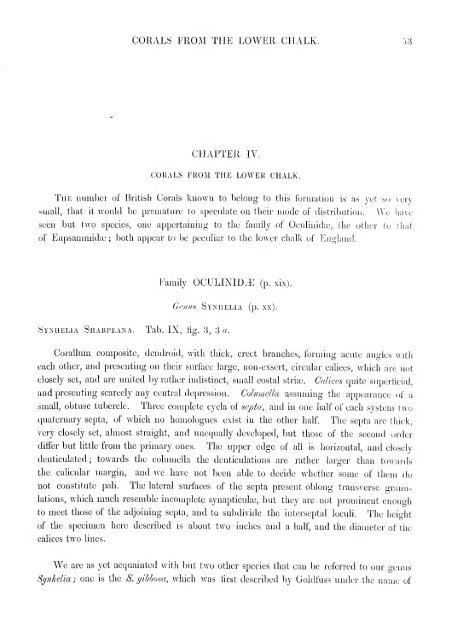A monograph of the British fossil corals - kreidefossilien.de
A monograph of the British fossil corals - kreidefossilien.de
A monograph of the British fossil corals - kreidefossilien.de
You also want an ePaper? Increase the reach of your titles
YUMPU automatically turns print PDFs into web optimized ePapers that Google loves.
CORALS FROM THE LOWER CHALK. 53<br />
CHAPTER IV.<br />
CORALS FROxM THE LOWER CHALK.<br />
The number <strong>of</strong> <strong>British</strong> Corals known to belong to this formation is as yet so very<br />
small, that it would be premature to speculate on <strong>the</strong>ir mo<strong>de</strong> <strong>of</strong> distribution. We have<br />
seen but two species, one appertaining to <strong>the</strong> family <strong>of</strong> Ocidinidse, <strong>the</strong> o<strong>the</strong>r to that<br />
<strong>of</strong> Eupsammidaj ; both appear to be peculiar to <strong>the</strong> lower chalk <strong>of</strong> England.<br />
Family<br />
OCULINID^ (p. xix).<br />
Genus Synhelia<br />
(p. xx).<br />
Stnhelia Shabpeana. Tab. IX, fig. 3, 3 a.<br />
Corallum composite, <strong>de</strong>ndroid, with thick, erect branches, forming acute angles with<br />
each o<strong>the</strong>r, and presenting on <strong>the</strong>ir surface large, non-exsert, cii'cular caUces, which are not<br />
closely set, and are united by ra<strong>the</strong>r indistinct, small costal striae.<br />
Calices quite superficial,<br />
and presenting scarcely any central <strong>de</strong>pression. Columella assuming <strong>the</strong> appearance <strong>of</strong> a<br />
small, obtuse tubercle. Three complete cycla <strong>of</strong> septa, and in one half <strong>of</strong> each system two<br />
quaternary septa, <strong>of</strong> which no homologues exist in <strong>the</strong> o<strong>the</strong>r half. The septa are thick,<br />
very closely set, almost straight, and unequally <strong>de</strong>veloped, but those <strong>of</strong> <strong>the</strong> second or<strong>de</strong>r<br />
differ but little from <strong>the</strong> primary ones. The upper edge <strong>of</strong> all is horizontal, and closely<br />
<strong>de</strong>nticulated; towards <strong>the</strong> columella <strong>the</strong> <strong>de</strong>nticidatious are ra<strong>the</strong>r larger than towards<br />
<strong>the</strong> calicular margin, and we have not been able to <strong>de</strong>ci<strong>de</strong> whe<strong>the</strong>r some <strong>of</strong> <strong>the</strong>m do<br />
not constitute pah. The lateral surfaces <strong>of</strong> <strong>the</strong> septa present oblong transverse granulations,<br />
which much resemble incomplete synapticulge, but <strong>the</strong>y are<br />
not prominent enough<br />
to meet those <strong>of</strong> <strong>the</strong> adjoining septa, and to subdivi<strong>de</strong> <strong>the</strong> interseptal locuh. The height<br />
<strong>of</strong> <strong>the</strong> specimen here <strong>de</strong>scribed is about two inches and a half, and <strong>the</strong> diameter <strong>of</strong> <strong>the</strong><br />
calices two lines.<br />
We are as yet acquainted with but two o<strong>the</strong>r species that can be referred to our genus<br />
Synhelia ; one is <strong>the</strong> 8. gibbosa, which was first <strong>de</strong>scribed by Goldfuss un<strong>de</strong>r <strong>the</strong> name <strong>of</strong>
















